-
Posts
336 -
Joined
-
Last visited
Content Type
Profiles
Forums
Events
Store
Downloads
Gallery
Posts posted by Mantis dude
-
-
Those darn Aussies always invading and inserting themselves in Japanese business. That's what happens when you make a wrong turn on your walkabout.
-
 1
1
-
-
Hi all,
So when I was reading the previous post on Kanayama and period of manufacture, a ko-katchushi tsuba came to mind and was curious if related to the time period. Going through Sasano's sukashi tsuba there is a nice pull out of examples of different schools through different time periods. However, in Sukashi Tsuba by Kokubo there is a tsuba labeled ko-katchusi that invokes that wabi Sabi feel and seems more open work than what most katchusi tsuba seem to be. Pg 27.
any comments on how ko-katchushi tsuba would fit into this discussion (if it all). Thanks
Ken
-
 1
1
-
-
-
Coincidently, I was searching for something else but came across this prior post on the topic:
I haven't very active on the forum for a long time. took me forever to catchup on old posts and before I get behind again I'm trying to participate. The forum has always been helpful and I just wanted to say thanks to the community. Hope you find the prior discussion relevant.
-
 2
2
-
-
10 hours ago, Cornelius said:
So far, I haven't really seen tsubas with representations of kamon, which could be an indication that the decoration/illustration of a tsuba was not in a very close connection with its owner.
I think I am still missing exactly what you are looking for- tsuba depicting kamon aren't uncommon. There are famous sukashi designs with kamon around the entire tsuba. even just typing in Kamon in this forum will show examples of tsuba or when I google plenty arise. I believe there has been discussion of 2 kamon on a tsuba that perhaps represented the joining of 2 families, although it might have been with fuchi kashira. However, you definitely find them on tsuba. I have a faint memory of someone asking if a tsuba could have belonged to samurai x based on the 2 kamon but that was really impossible to figure out. Is that the sort of information you are looking for?
-
-
Thanks Guys for your input! It always seems when I translate I looked at it and go "I think I recognize that, it should be easy to decipher". But I am always wrong and it takes a lot of work or luck (I am not nor have I had any formal training in Kanji- should have learned how to write properly). I do and try and hand copy it which helps sometimes, makes you pay attention to the cuts, shape of punches, etc. Not studying stroke orders is a handicap in this endeavor.
Moving on- First off, I have to correct a mistake I usually assume 4 dots at the bottom is Kane not Kuni as a starting point- mistyping on a post just stares at you in the face and taunts me, although we all mistype. Jack, I apologize, I wasn't understanding what you were asking for and I should have posted the kanji earlier (Thanks Piers).
The validity of the mei is a whole other subject and with this small an area, I know it is more likely to have variation. And as you stated, the piece should validate the mei, although as humans we usually swap that. Anyway, here is the set. I haven't done any real research in the school yet so comments are appreciated. The excitement of finding kanji took over! It was listed as momoyama- muramachi time frame but I think it is later.

Thanks you for all your input or just viewing. Any input is always welcome, even disagreements are good.... well depending on how we disagree but personalities never clash here (Brian just shook his head).
Ken
-
 3
3
-
-
I was so excited I thought I cracked the code but it might help take you through my thought process and see if you can see it like I do:
This breakdown is just for the 2nd character - "hide" I think is fairly straight forward. Anytime I see dots at the bottom I automatically think kuni (i know there are others but it usually a good starting point). But that wasn't fitting. One of the things I was struggling with was holding the damn menuki in gloves to just see the kanji. Really required good lighting otherwise lines disappeared- remember this is a very tiny area. But when I got the correct lighting I could see very discrete marks. They were placed with purpose. So the 2 marks at the bottom, I thought are 2 marks not 4, eliminating all those variations. Getting no where, I was just looking through Haynes signatures when I came across Hideoki. I thought the design was plausible for school although I didn't research it- insects are a school theme (i know I owe a whole photo). So I went and looked up hideoki in toso kodogu meiji taikei by Wakayama. Here are some random examples from the book which was the lightbulb moment as you will see (i hope). If you look at sig ex3 I circled the area if you removed would look a lot like my signature. I think since the space was so small, the smith used a "/" at the top of left straight line down of the "steps" to indicate the far left line. The formal signature was no help but looking at how they actually signed made the difference to my eyes. now what do you think of my code cracking?
-
 1
1
-
-
At least take me to dinner first.......
I knew more pics would be requested. At some point, I'll post them. Above mei pic, far left is shakudo mantis with gold butterfly at the top. Right is a cricket done in suaka (?not sure)
-
 1
1
-
-
Hi all,
So anyone that wins an auction waits for the package to arrive, hoping it is what they thought when bidding on. I received a menuki set which I liked the looks of and was a design I didn't have anything similar too. That alone was reason enough to be excited by the set. When I received it, I just gave it a quite look over, liking the looks of it and it seemed like I made a good buy. I placed it on the side for further analysis. So I finally got the old lighted magnifying glass out, looking at it under magnification. As I was turning it around, I came to the bottom of the menuki edges and something caught my eye. As I played to get the best light on the area I got very excited.... There is a kanji character there. "Is this piece signed?", I said to myself. I quickly grabbed the other piece looked at the bottom and had to play a lot with the light to see, yes there is another kanji character (each menuki had 1 character). Now this is a pleasant surprise! The auction description made no mention of it being signed, claiming it was older momoyama to muromachi period.
Next task decipher it. I am pretty sure I got the 1st kanji correctly as "hide". The second kanji was much harder to find. Just seeing it clearly was an issue, struggling to get the light right so I could see the entire character. The biggest issue is that the space on the menuki is only 2.5-3mm, pretty small area to punch a character in too. I believe after a long while of studying that the 2nd kanji is "oki". together it is a menuki set possibly signed "Hideoki", a Student of otsuki mitsuaki. The design would fit the school - not posting entire set but you can assume it has 1 particular insect.... hmmm which one... perhaps a mantis, along with a butterfly and cricket. I could have sworn I saw a similar set in a book but can't find the picture. So what do you guys think? Here is a photo of the bottoms along with the kanji (what a pain to get a picture taken). Appreciate any help or comments. thanks.
Ken
-
 2
2
-
 2
2
-
-
Both scenarios I believe are in play. Schools produced their work, copying designs. The designs had to appeal to users. Trends and fashions effected the designs to appeal to evolving tastes. I think this is how most pieces where created and sold. However, you could order a specific design or construct which I think more upper echelon individuals chose this method.
-
 4
4
-
 1
1
-
-
Jake,
Appreciate the feedback. As I said, it was a set that came with a lot I won. Always good to get some decent quality pieces with the item you really wanted. I had looked at the set but hadn't even tried to verify the mei until yesterday afternoon. The mei seemed plausible but not exact- this is where a lot of my signature's seem to lie. Why can't they make this stuff easier! All the best. Thanks.
Ken
-
The reason I replied to an old post was I was trying to do a little research on this fuchi/kashira which is mounted and on auction at this moment. Was curious what school (if any) that comes to mind? I was wondering if it could be Nara? I'll expand on why Later. Just looking for some quick opinions. Thanks!
-
Sorry, I realized this was an old post which I replied to. Came up in my search of something else but was just trying to catchup on my nmb reading and I didn't realize until after. oh well, still a nice f/k set.
-
Figured I add a similar F/K but with a more specific signature: Nara Toshimitsu. I recently acquired this in a lot and was happily surprised/enjoyed the detailed work. Not sure if it is a gimei or not, but I think generally it certainly fits the school work. Definitely made me aware of this Nara style.
all the best,
Ken
-
 3
3
-
-
I saw a documentary on the Roman Emperor Constantine who was the one that adopted Christianity as the main religion for Rome. Checking on his military conquest monument in Paris, they wanted to see the imagery being displayed to determine if he was a "true" believer or not. Christianity appealed to lots of Roman soldiers, especially the idea of forgiveness and continuation of the soul in the afterlife. looking at the monument both pagan and Christian symbols were used meaning it seemed he was hedging his bets paying respect to the old and new ways, more of a political move. one pagan image was a halo type symbol that we see Christians start using to depict Christ with. Basically like many other instances in human history, prior religious imagery had morphed into the "new" religion. Was interesting to see how the political side of religion was used along with the evolution of old symbols into new ones. So seeing imagery as both would make sense.
-
 2
2
-
-
Hi Jake,
Just a few simple things to look at- when you look at goto work you are usually looking at excellent and precise execution. Look at the nanako on a verified goto piece. Compare that with yours and you can see there is a big difference in execution and precision. The precision of design and carving in any design a goto artist does is crisp and flows. Look at your horses, they look a bit muddled in comparison. Not trying to knock your piece, just pointing out a few things that caught my eye immediately. I don't know lot about the Goto school but have overtime come across lots of pictures (wish more in hand). You start to see what goes into a quality piece by breaking down the details. There is a reason why the Goto school is so respected. I am guilty as most, looking at the signature 1st. But we always heard from the "older crowd" that the "workmanship confirms the signature " and I understand why now more than when I first started collecting. Why is this so hard to accept? Simply, it points out how much I don't know. Lol. Best of luck and I'm glad you are enjoying what you have.
-
 2
2
-
-
13 hours ago, 1kinko said:
Hallam School. Original 2019, shibuichi on copper.
Special piece for sure
-
1st off- I am away so I can't check but is the " mantis dude" the only one that doesn't have one of those?!!
2nd I don't recall seeing a similar mantis design like the Last one posted. Any details about it? School etc?
Awesome taste gentlemen & ladies.
-
-
Hi all,
Yes, I have found many similar designs- most I would attribute to aizu shoami (or just shoami school). although, I have seen many examples from other schools that were more just copies from a design book. I agree with Ian that they are mediocre. I try and focus on other designs now but I do have some with similar look and feel. I also have tsuba that are the same design but each plate is a different shape. I do find it interesting to see them in a group together. Since these aren't great pieces I would be happy to keep them for you guys. Remember to send me your tired, your lonely mantis tosogou. For that matter, I'll take the in shape and happy pieces as well.
All the best.
Ken
-
 1
1
-
 1
1
-
 1
1
-
-
-
Sorry don't have those articles. But out of curiosity- is the 6th generation the yasuchika that did these rat w/ mirrors and/or rats w/ Chinese scroll? The description describes the rats are piebald and while I hadn't heard that adjective before- it makes sense after looking up
piebald • \PYE-bawld\ • adjective. 1 : composed of incongruous parts 2 : of different colors; especially : spotted or blotched with black and white.
The rats are gold/ shakudo. Lots of motif examples by Yasuchika.
A few Examples:
https://www.christie...m/en/lot/lot-5618017
https://www.ebay.com...=ps&mkevt=1&mkcid=28
https://www.ebay.com/itm/326005918226
Thanks,
Ken aka "the mantis dude"
Mantisdude.com
-
Collin- I think you may be correct. I don't remember seeing an Iron covered mimi like this, perhaps because of the minimal color difference ( I'm partially color blind and sometimes don't see shades as well).
Steve- interesting tidbit if true. I will have to pay more attention and see if this is true. As we all know though, there seems to be exceptions to every rule in this hobby.
Thanks for the feedback!
-
 1
1
-



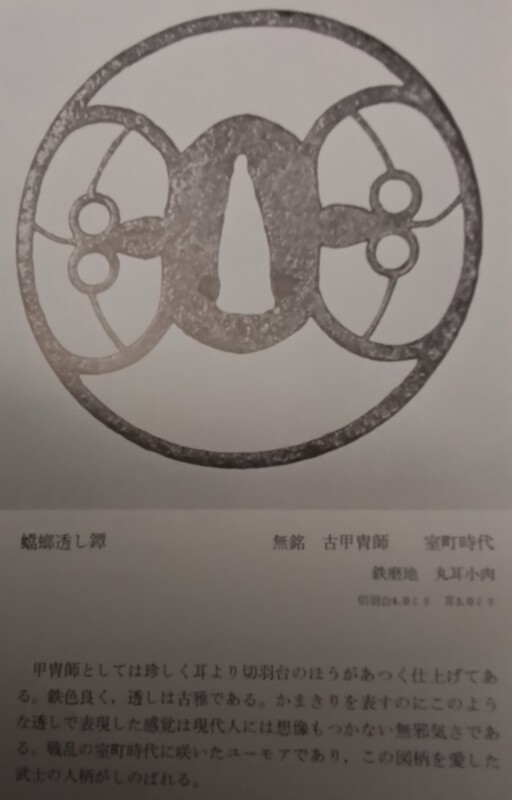

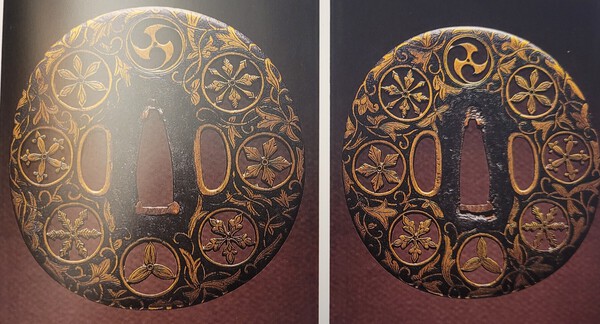






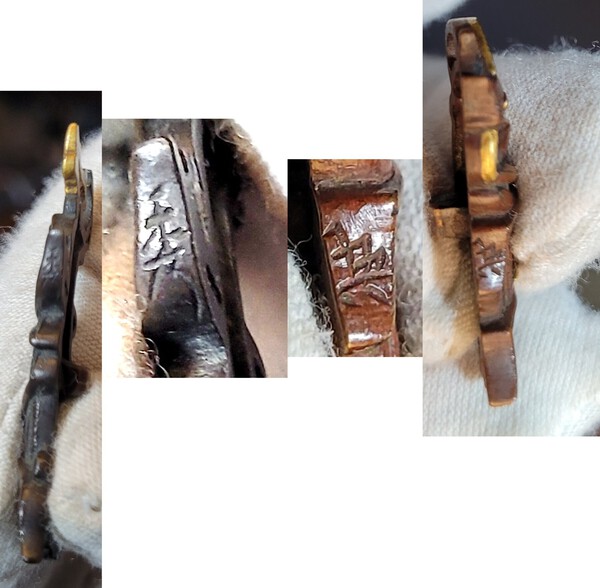

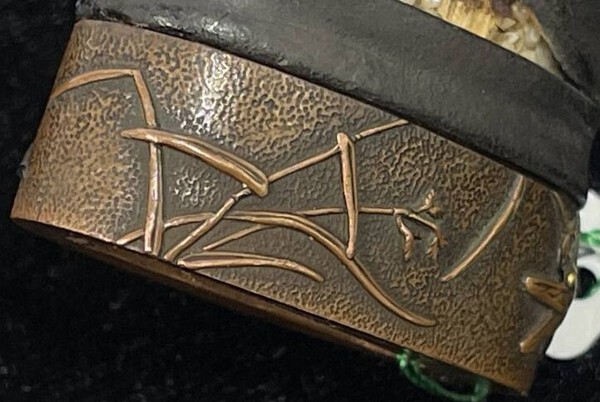




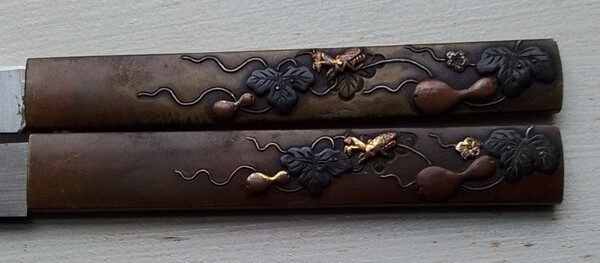

Kanayama follow up..... sort of- wabisabi influence
in Tosogu
Posted
Just to give a better view than the book tsuba- here is an actual tsuba. size 92x90x5mm@seppa dai & 4mm mimi